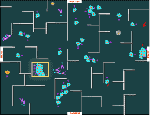About
Yanna Vogiazou was a PhD student in KMi her research was focused on the notion of ‘presence’ in the online and wireless-connected world and investigated the potential of massive multiplayer games and playful multi-user interaction based purely on ‘presence’ information. For this purpose, her research used examples from interdisciplinary areas, such as social psychology experiments, multiplayer game design, and Instant Messaging. Ideas were being developed on how the number of players could work more as an advantage rather than a restriction in a ‘presence’-based multiplayer game.
The research examined the concept of ‘presence’ as a sense of being connected or in touch with others. It highlighted that ‘presence’ information—such as knowledge of a person’s existence, availability, activity, and location—had become a crucial aspect of the connected and wireless world. Originally a simple online/offline status, the concept had evolved to include richer details.
Instant Messaging applications, for example, had expanded ‘presence’ functions to include availability, willingness to communicate, location, activity, device capability, and even more complex aspects like mood, intention, and identity. These features had promising potential, particularly in gaming and playful applications. The study aimed to define ‘presence’ on a large scale and develop a framework for multiplayer game design experimentation based on presence information.
The research sought to explore how ‘presence awareness’ could influence interactions among large groups of people and enhance their experience in online and wireless environments. It questioned how design could amplify the feeling of being part of a crowd. In multiplayer games, player-to-player interaction had limitations—either in the number of participants or the extent to which they could interact or see each other. Even in large-scale games like Ultima Online, where thousands played simultaneously, artificial constraints, such as the radar horizon, restricted full immersion.
The study aimed to investigate the possibility of a game where the presence of a large number of players was not only beneficial but central to its mechanics. It also sought to create playful group interactions based on simultaneous large-scale participation. To support this, the research drew from social psychology, referencing Alexander Mintz’s 1951 study on crowd panic behavior. His experimental ‘panic simulation’ suggested that people adjusted their behavior based on expectations of others. Similarly, Henri Tajfel’s Minimal Identity Theory (1970) demonstrated that even arbitrary group divisions influenced behavior. These insights inspired the potential development of a new genre of massively multiplayer ‘crowd behavior’ games, incorporating intergroup competition.
The research posed several key questions:
- How could design enhance social interaction for large numbers of players in a playful way?
- Was a truly massive multiplayer game feasible, and what were the scale limitations?
- What design guidelines were necessary for different devices, including online and wireless interactions?
- How could presence information be effectively communicated?
- How would the presence of large numbers of people impact the gaming experience?
- Would such an environment function as a game or more as a social gathering?
A series of game concepts were being developed to explore this area and gather initial feedback. Although the research was conducted on an experimental basis, emerging technological trends were encouraging. Since large-scale social interaction through play had not yet been widely studied, the challenge remained an exciting and unexplored frontier.
For more work in KMi related to Enhanced Presence Management and Instant Messaging (IM), refer to https://research-archive.stem.open.ac.uk/buddyspace/. For background information in the area and related telepresence/webcasting work, visit KMi Stadium.
Design Concepts
A series of game concepts that were under development as part of the research.
Maze concept
A maze-like hunting game, where one color-coded group attempted to capture another, which tried to find the right exit to escape.

Time Travel Game
This concept took advantage of location-based technologies on wireless platforms and players’ presence information with the goal of discovering a city map more than a hundred years old.

Wireless Tag Game
A multiplayer chasing game on a mobile phone, originating from the ‘tag’ playground game.
